[转] Understanding-LSTMs 理解LSTM
图文并茂,讲得极清晰。
原文:http://colah.github.io/posts/2015-08-Understanding-LSTMs/
Understanding LSTM Networks
Posted on August 27, 2015
Recurrent Neural Networks
Humans don’t start their thinking from scratch every second. As you read this essay, you understand each word based on your understanding of previous words. You don’t throw everything away and start thinking from scratch again. Your thoughts have persistence.
Traditional neural networks can’t do this, and it seems like a major shortcoming. For example, imagine you want to classify what kind of event is happening at every point in a movie. It’s unclear how a traditional neural network could use its reasoning about previous events in the film to inform later ones.
Recurrent neural networks address this issue. They are networks with loops in them, allowing information to persist.

In the above diagram, a chunk of neural network, \(A\), looks at some input \(x_t\) and outputs a value \(h_t\). A loop allows information to be passed from one step of the network to the next.
These loops make recurrent neural networks seem kind of mysterious. However, if you think a bit more, it turns out that they aren’t all that different than a normal neural network. A recurrent neural network can be thought of as multiple copies of the same network, each passing a message to a successor. Consider what happens if we unroll the loop:

This chain-like nature reveals that recurrent neural networks are intimately related to sequences and lists. They’re the natural architecture of neural network to use for such data.
And they certainly are used! In the last few years, there have been incredible success applying RNNs to a variety of problems: speech recognition, language modeling, translation, image captioning… The list goes on. I’ll leave discussion of the amazing feats one can achieve with RNNs to Andrej Karpathy’s excellent blog post, The Unreasonable Effectiveness of Recurrent Neural Networks. But they really are pretty amazing.
Essential to these successes is the use of “LSTMs,” a very special kind of recurrent neural network which works, for many tasks, much much better than the standard version. Almost all exciting results based on recurrent neural networks are achieved with them. It’s these LSTMs that this essay will explore.
The Problem of Long-Term Dependencies
One of the appeals of RNNs is the idea that they might be able to connect previous information to the present task, such as using previous video frames might inform the understanding of the present frame. If RNNs could do this, they’d be extremely useful. But can they? It depends.
Sometimes, we only need to look at recent information to perform the present task. For example, consider a language model trying to predict the next word based on the previous ones. If we are trying to predict the last word in “the clouds are in the sky,” we don’t need any further context – it’s pretty obvious the next word is going to be sky. In such cases, where the gap between the relevant information and the place that it’s needed is small, RNNs can learn to use the past information.
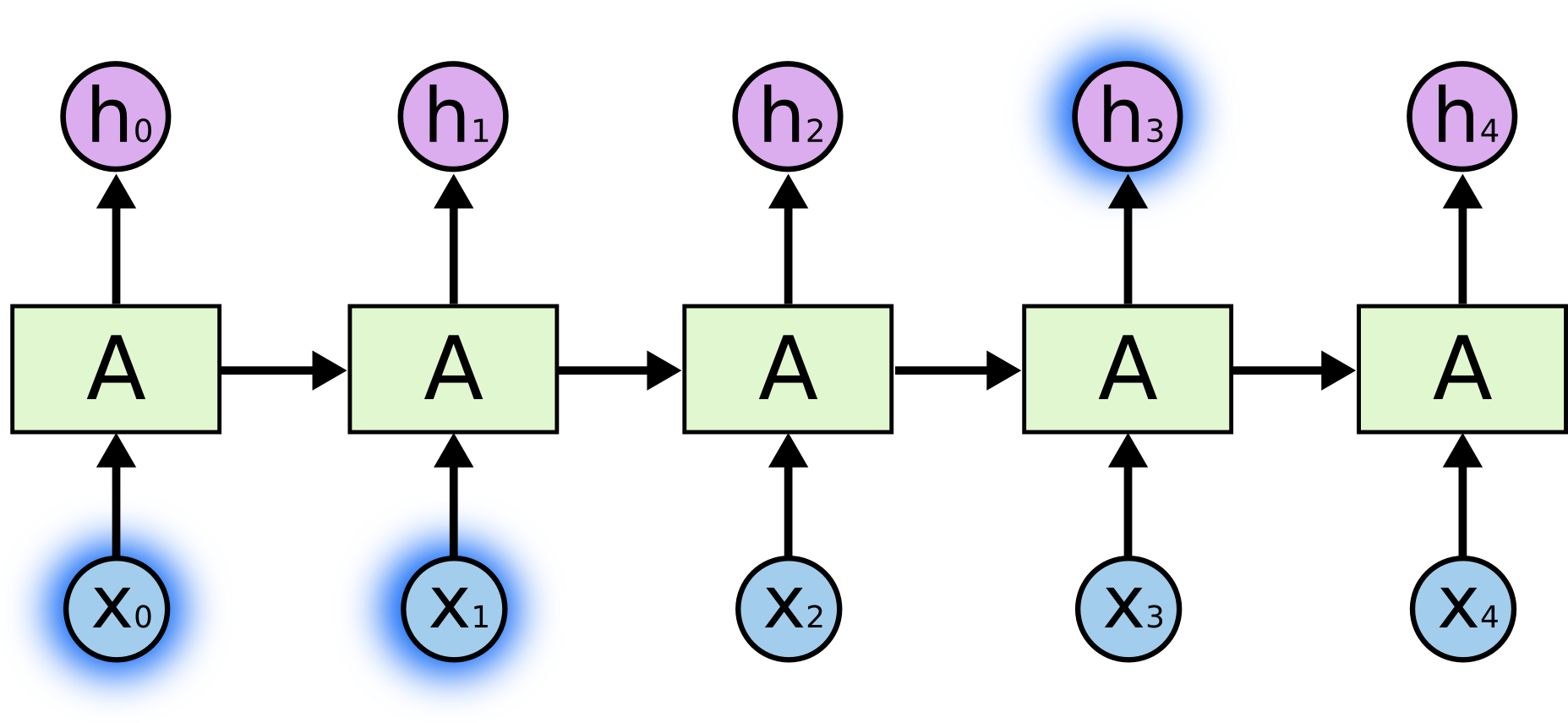
But there are also cases where we need more context. Consider trying to predict the last word in the text “I grew up in France… I speak fluent French.” Recent information suggests that the next word is probably the name of a language, but if we want to narrow down which language, we need the context of France, from further back. It’s entirely possible for the gap between the relevant information and the point where it is needed to become very large.
Unfortunately, as that gap grows, RNNs become unable to learn to connect the information.
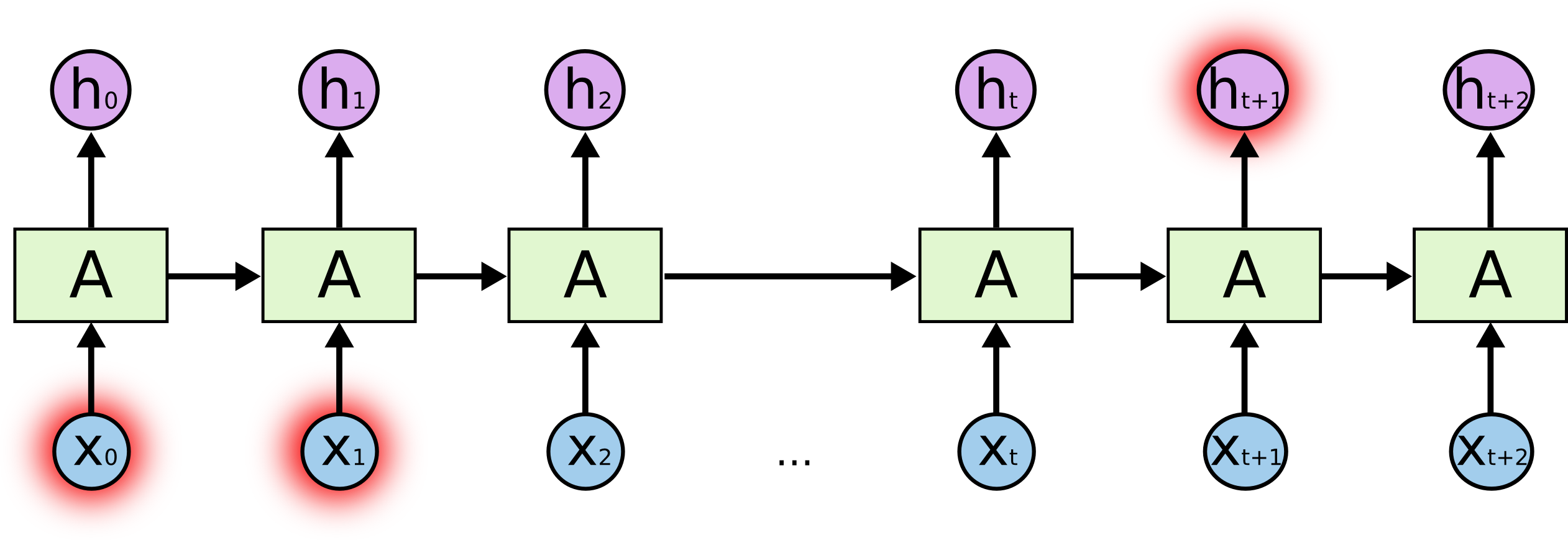
In theory, RNNs are absolutely capable of handling such “long-term dependencies.” A human could carefully pick parameters for them to solve toy problems of this form. Sadly, in practice, RNNs don’t seem to be able to learn them. The problem was explored in depth by Hochreiter (1991) [German] and Bengio, et al. (1994), who found some pretty fundamental reasons why it might be difficult.
Thankfully, LSTMs don’t have this problem!
LSTM Networks
Long Short Term Memory networks – usually just called “LSTMs” – are a special kind of RNN, capable of learning long-term dependencies. They were introduced by Hochreiter & Schmidhuber (1997), and were refined and popularized by many people in following work.1 They work tremendously well on a large variety of problems, and are now widely used.
LSTMs are explicitly designed to avoid the long-term dependency problem. Remembering information for long periods of time is practically their default behavior, not something they struggle to learn!
All recurrent neural networks have the form of a chain of repeating modules of neural network. In standard RNNs, this repeating module will have a very simple structure, such as a single tanh layer.
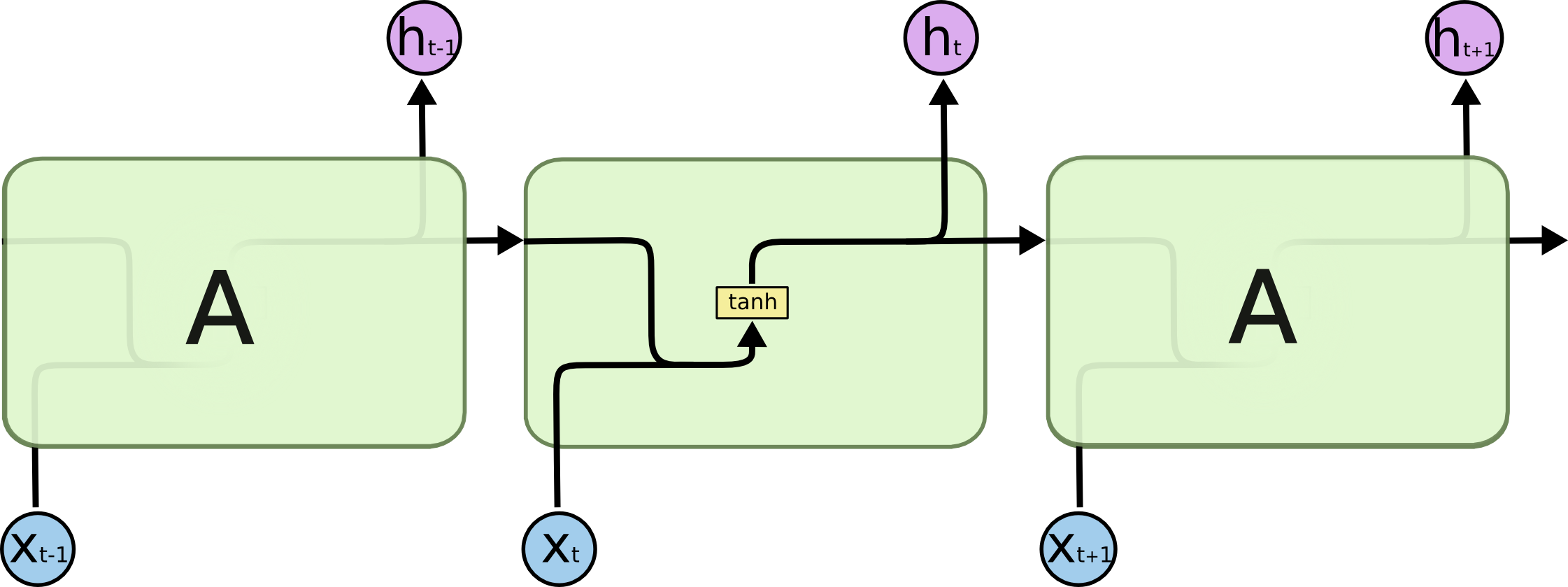
LSTMs also have this chain like structure, but the repeating module has a different structure. Instead of having a single neural network layer, there are four, interacting in a very special way.
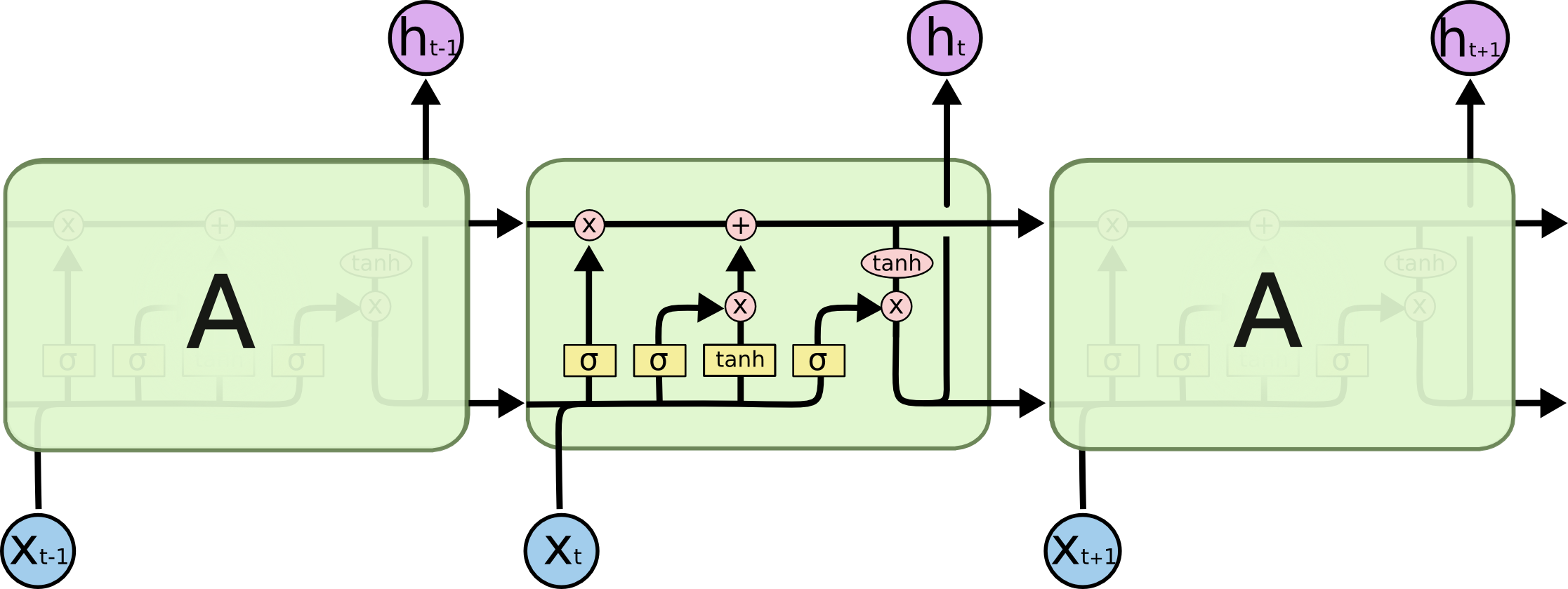
Don’t worry about the details of what’s going on. We’ll walk through the LSTM diagram step by step later. For now, let’s just try to get comfortable with the notation we’ll be using.

In the above diagram, each line carries an entire vector, from the output of one node to the inputs of others. The pink circles represent pointwise operations, like vector addition, while the yellow boxes are learned neural network layers. Lines merging denote concatenation, while a line forking denote its content being copied and the copies going to different locations.
The Core Idea Behind LSTMs
The key to LSTMs is the cell state, the horizontal line running through the top of the diagram.
The cell state is kind of like a conveyor belt. It runs straight down the entire chain, with only some minor linear interactions. It’s very easy for information to just flow along it unchanged.

The LSTM does have the ability to remove or add information to the cell state, carefully regulated by structures called gates.
Gates are a way to optionally let information through. They are composed out of a sigmoid neural net layer and a pointwise multiplication operation.
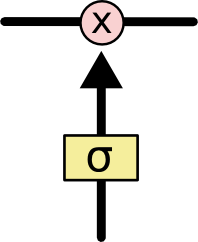
The sigmoid layer outputs numbers between zero and one, describing how much of each component should be let through. A value of zero means “let nothing through,” while a value of one means “let everything through!”
An LSTM has three of these gates, to protect and control the cell state.
Step-by-Step LSTM Walk Through
The first step in our LSTM is to decide what information we’re going to throw away from the cell state. This decision is made by a sigmoid layer called the “forget gate layer.” It looks at \(h_{t-1}\) and \(x_t\), and outputs a number between \(0\) and \(1\) for each number in the cell state \(C_{t-1}\). A \(1\) represents “completely keep this” while a \(0\) represents “completely get rid of this.”
Let’s go back to our example of a language model trying to predict the next word based on all the previous ones. In such a problem, the cell state might include the gender of the present subject, so that the correct pronouns can be used. When we see a new subject, we want to forget the gender of the old subject.

The next step is to decide what new information we’re going to store in the cell state. This has two parts. First, a sigmoid layer called the “input gate layer” decides which values we’ll update. Next, a tanh layer creates a vector of new candidate values, \(\tilde{C}_t\), that could be added to the state. In the next step, we’ll combine these two to create an update to the state.
In the example of our language model, we’d want to add the gender of the new subject to the cell state, to replace the old one we’re forgetting.

It’s now time to update the old cell state, \(C_{t-1}\), into the new cell state \(C_t\). The previous steps already decided what to do, we just need to actually do it.
We multiply the old state by \(f_t\), forgetting the things we decided to forget earlier. Then we add \(i_t*\tilde{C}_t\). This is the new candidate values, scaled by how much we decided to update each state value.
In the case of the language model, this is where we’d actually drop the information about the old subject’s gender and add the new information, as we decided in the previous steps.

Finally, we need to decide what we’re going to output. This output will be based on our cell state, but will be a filtered version. First, we run a sigmoid layer which decides what parts of the cell state we’re going to output. Then, we put the cell state through \(\tanh\) (to push the values to be between \(-1\) and \(1\)) and multiply it by the output of the sigmoid gate, so that we only output the parts we decided to.
For the language model example, since it just saw a subject, it might want to output information relevant to a verb, in case that’s what is coming next. For example, it might output whether the subject is singular or plural, so that we know what form a verb should be conjugated into if that’s what follows next.

Variants on Long Short Term Memory
What I’ve described so far is a pretty normal LSTM. But not all LSTMs are the same as the above. In fact, it seems like almost every paper involving LSTMs uses a slightly different version. The differences are minor, but it’s worth mentioning some of them.
One popular LSTM variant, introduced by Gers & Schmidhuber (2000), is adding “peephole connections.” This means that we let the gate layers look at the cell state.

The above diagram adds peepholes to all the gates, but many papers will give some peepholes and not others.
Another variation is to use coupled forget and input gates. Instead of separately deciding what to forget and what we should add new information to, we make those decisions together. We only forget when we’re going to input something in its place. We only input new values to the state when we forget something older.

A slightly more dramatic variation on the LSTM is the Gated Recurrent Unit, or GRU, introduced by Cho, et al. (2014). It combines the forget and input gates into a single “update gate.” It also merges the cell state and hidden state, and makes some other changes. The resulting model is simpler than standard LSTM models, and has been growing increasingly popular.

These are only a few of the most notable LSTM variants. There are lots of others, like Depth Gated RNNs by Yao, et al. (2015). There’s also some completely different approach to tackling long-term dependencies, like Clockwork RNNs by Koutnik, et al. (2014).
Which of these variants is best? Do the differences matter? Greff, et al. (2015) do a nice comparison of popular variants, finding that they’re all about the same. Jozefowicz, et al. (2015)tested more than ten thousand RNN architectures, finding some that worked better than LSTMs on certain tasks.
Conclusion
Earlier, I mentioned the remarkable results people are achieving with RNNs. Essentially all of these are achieved using LSTMs. They really work a lot better for most tasks!
Written down as a set of equations, LSTMs look pretty intimidating. Hopefully, walking through them step by step in this essay has made them a bit more approachable.
LSTMs were a big step in what we can accomplish with RNNs. It’s natural to wonder: is there another big step? A common opinion among researchers is: “Yes! There is a next step and it’s attention!” The idea is to let every step of an RNN pick information to look at from some larger collection of information. For example, if you are using an RNN to create a caption describing an image, it might pick a part of the image to look at for every word it outputs. In fact, Xu, et al.(2015) do exactly this – it might be a fun starting point if you want to explore attention! There’s been a number of really exciting results using attention, and it seems like a lot more are around the corner…
Attention isn’t the only exciting thread in RNN research. For example, Grid LSTMs by Kalchbrenner, et al. (2015) seem extremely promising. Work using RNNs in generative models – such as Gregor, et al. (2015), Chung, et al. (2015), or Bayer & Osendorfer (2015) – also seems very interesting. The last few years have been an exciting time for recurrent neural networks, and the coming ones promise to only be more so!
Acknowledgments
I’m grateful to a number of people for helping me better understand LSTMs, commenting on the visualizations, and providing feedback on this post.
I’m very grateful to my colleagues at Google for their helpful feedback, especially Oriol Vinyals, Greg Corrado, Jon Shlens, Luke Vilnis, and Ilya Sutskever. I’m also thankful to many other friends and colleagues for taking the time to help me, including Dario Amodei, and Jacob Steinhardt. I’m especially thankful to Kyunghyun Cho for extremely thoughtful correspondence about my diagrams.
Before this post, I practiced explaining LSTMs during two seminar series I taught on neural networks. Thanks to everyone who participated in those for their patience with me, and for their feedback.
In addition to the original authors, a lot of people contributed to the modern LSTM. A non-comprehensive list is: Felix Gers, Fred Cummins, Santiago Fernandez, Justin Bayer, Daan Wierstra, Julian Togelius, Faustino Gomez, Matteo Gagliolo, and Alex Graves.↩
More Posts

Attention and Augmented Recurrent Neural Networks
On Distill

Conv Nets
A Modular Perspective

Neural Networks, Manifolds, and Topology
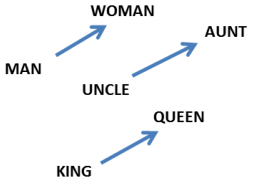
Deep Learning, NLP, and Representations
Comments
[转] Understanding-LSTMs 理解LSTM的更多相关文章
- (译)理解 LSTM 网络 (Understanding LSTM Networks by colah)
@翻译:huangyongye 原文链接: Understanding LSTM Networks 前言:其实之前就已经用过 LSTM 了,是在深度学习框架 keras 上直接用的,但是到现在对LST ...
- 【翻译】理解 LSTM 网络
目录 理解 LSTM 网络 递归神经网络 长期依赖性问题 LSTM 网络 LSTM 的核心想法 逐步解析 LSTM 的流程 长短期记忆的变种 结论 鸣谢 本文翻译自 Christopher Olah ...
- [译] 理解 LSTM 网络
原文链接:http://colah.github.io/posts/2015-08-Understanding-LSTMs/ 吴恩达版:http://www.ai-start.com/dl2017/h ...
- [译] 理解 LSTM(Long Short-Term Memory, LSTM) 网络
本文译自 Christopher Olah 的博文 Recurrent Neural Networks 人类并不是每时每刻都从一片空白的大脑开始他们的思考.在你阅读这篇文章时候,你都是基于自己已经拥有 ...
- [转] 理解 LSTM 网络
[译] 理解 LSTM 网络 http://www.jianshu.com/p/9dc9f41f0b29 Recurrent Neural Networks 人类并不是每时每刻都从一片空白的大脑开始他 ...
- 『cs231n』RNN之理解LSTM网络
概述 LSTM是RNN的增强版,1.RNN能完成的工作LSTM也都能胜任且有更好的效果:2.LSTM解决了RNN梯度消失或爆炸的问题,进而可以具有比RNN更为长时的记忆能力.LSTM网络比较复杂,而恰 ...
- 【翻译】理解 LSTM 及其图示
目录 理解 LSTM 及其图示 本文翻译自 Shi Yan 的博文 Understanding LSTM and its diagrams,原文阐释了作者对 Christopher Olah 博文 U ...
- RNN(1) ------ “理解LSTM”(转载)
原文链接:http://www.jianshu.com/p/9dc9f41f0b29 Recurrent Neural Networks 人类并不是每时每刻都从一片空白的大脑开始他们的思考.在你阅读这 ...
- 技能|三次简化一张图:一招理解LSTM/GRU门控机制
作者 | 张皓 引言 RNN是深度学习中用于处理时序数据的关键技术, 目前已在自然语言处理, 语音识别, 视频识别等领域取得重要突破, 然而梯度消失现象制约着RNN的实际应用.LSTM和GRU是两种目 ...
- 【转载】MDX Step by Step 读书笔记(三) - Understanding Tuples (理解元组)
1. 在 Analysis Service 分析服务中,Cube (多维数据集) 是以一个多维数据空间来呈现的.在Cube 中,每一个纬度的属性层次结构都形成了一个轴.沿着这个轴,在属性层次结构上的每 ...
随机推荐
- pstack跟踪进程栈
一:简介 这个命令可以显示每个进程的栈跟踪.pstack命令必须由相应进程的宿主或root运行.可以使用pstack来确定进程挂起的位置.此命令允许使用唯一选项就是进程的PID 这个命令在排查进程问题 ...
- POJ1821 单调队列//ST表 优化dp
http://poj.org/problem?id=1821 当我们在考虑内层循环j以及决策k的时候,我们可以把外层变量i看作定值,以此来优化dp状态转移方程. 题意 有n个工人准备铺m个连续的墙,每 ...
- mysql性能分析工具
一.EXPALIN 在SQL语句之前加上EXPLAIN关键字就可以获取这条SQL语句执行的计划 那么返回的这些字段是什么呢? 我们先关心一下比较重要的几个字段: 1. select_type 查询类型 ...
- 谈谈关于PHP连接数据库的两种方法(PDO&Mysqli)
前言:在我们之前学习sql语句的时候都是停留在黑窗口的,怎样才能让mysql与程序代码发生联系呢?此时PDO和Mysqli应运而生,为了解决这个问题 (一)开启其中(pdo或者mysqli)的php扩 ...
- bash guide
Table of Contents Basic Operations 1.1. File Operations 1.2. Text Operations 1.3. Directory Operatio ...
- node 跨域请求设置
http.createServer((req,res)=>{ //设置允许跨域的域名,*代表允许任意域名跨域 res.setHeader("Access-Control-Allow-O ...
- None.js 第五步 Buffer(缓冲区)
// 存数据,取数据; buf = Buffer.alloc(26); for (var i = 0; i < 26; i++) { buf[i] = i + 97; } console.log ...
- Play XML Entities
链接:https://pentesterlab.com/exercises/play_xxe/course Introduction This course details the exploitat ...
- 【SRM-09 B】撕书II
Description 琉璃手头有一黑一白两本魔法书,一本是<缟玛瑙的不在证明>,另一本是<白色相簿1.5>.传说同时打开这两本书会有奇怪的事情发生.琉璃打开一看,果然非常奇怪 ...
- 深度学习 ——style reconstruction
多层神经网络的实质就是为了找出更复杂,更内在的features...图像的style, how to describe, impossible! 但是人眼却可以分辨. (参考论文 A Neural a ...
